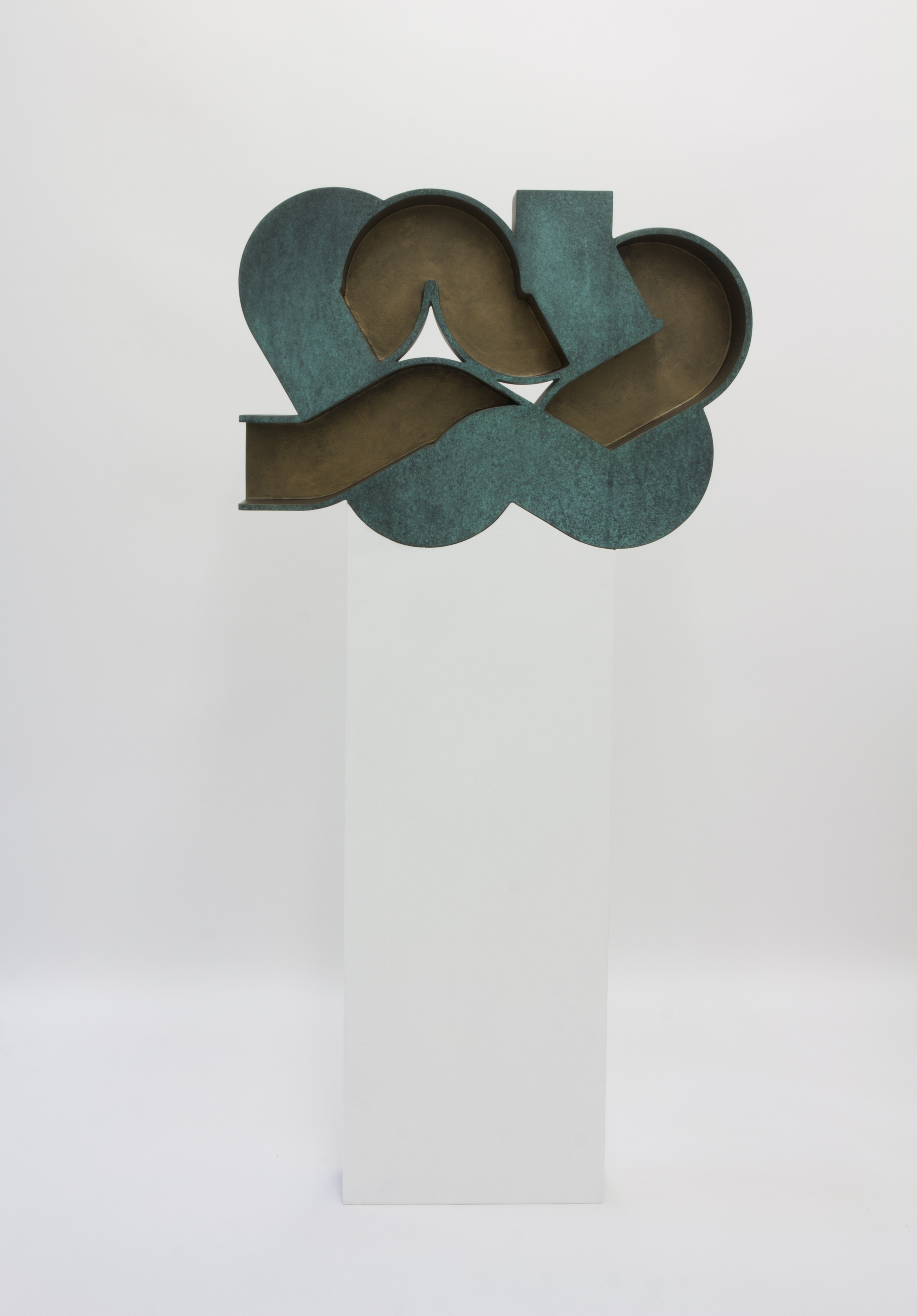




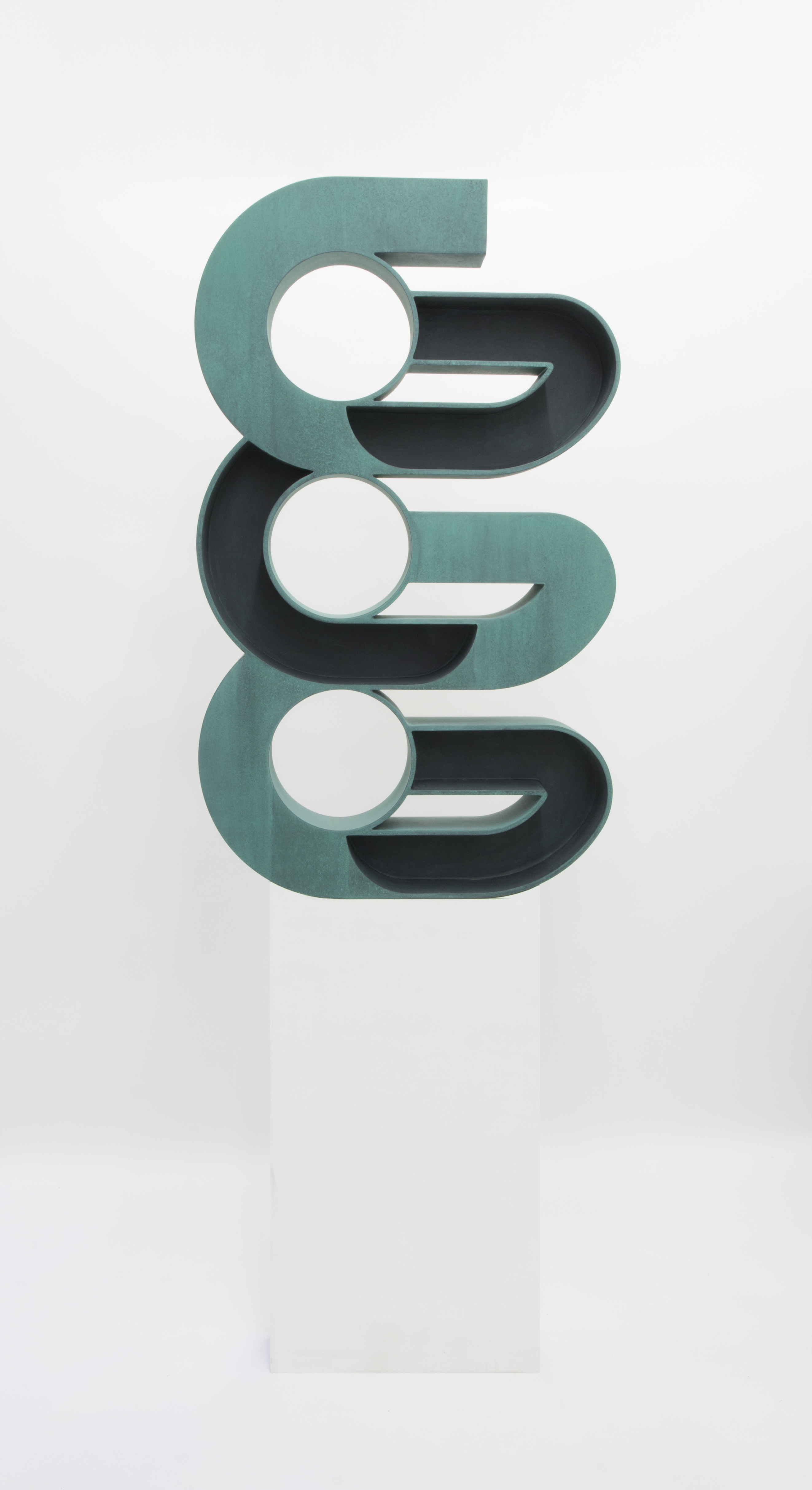
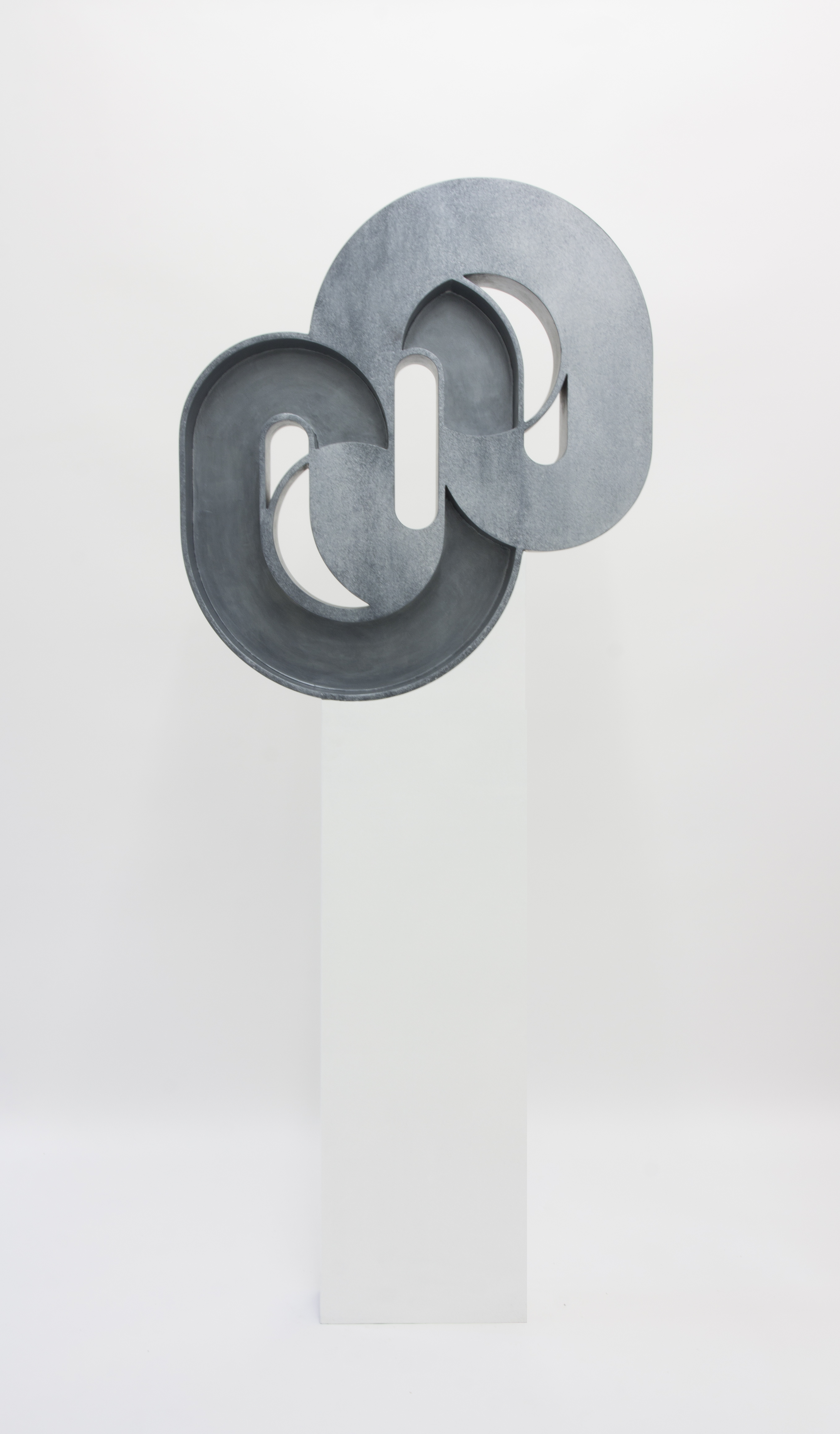



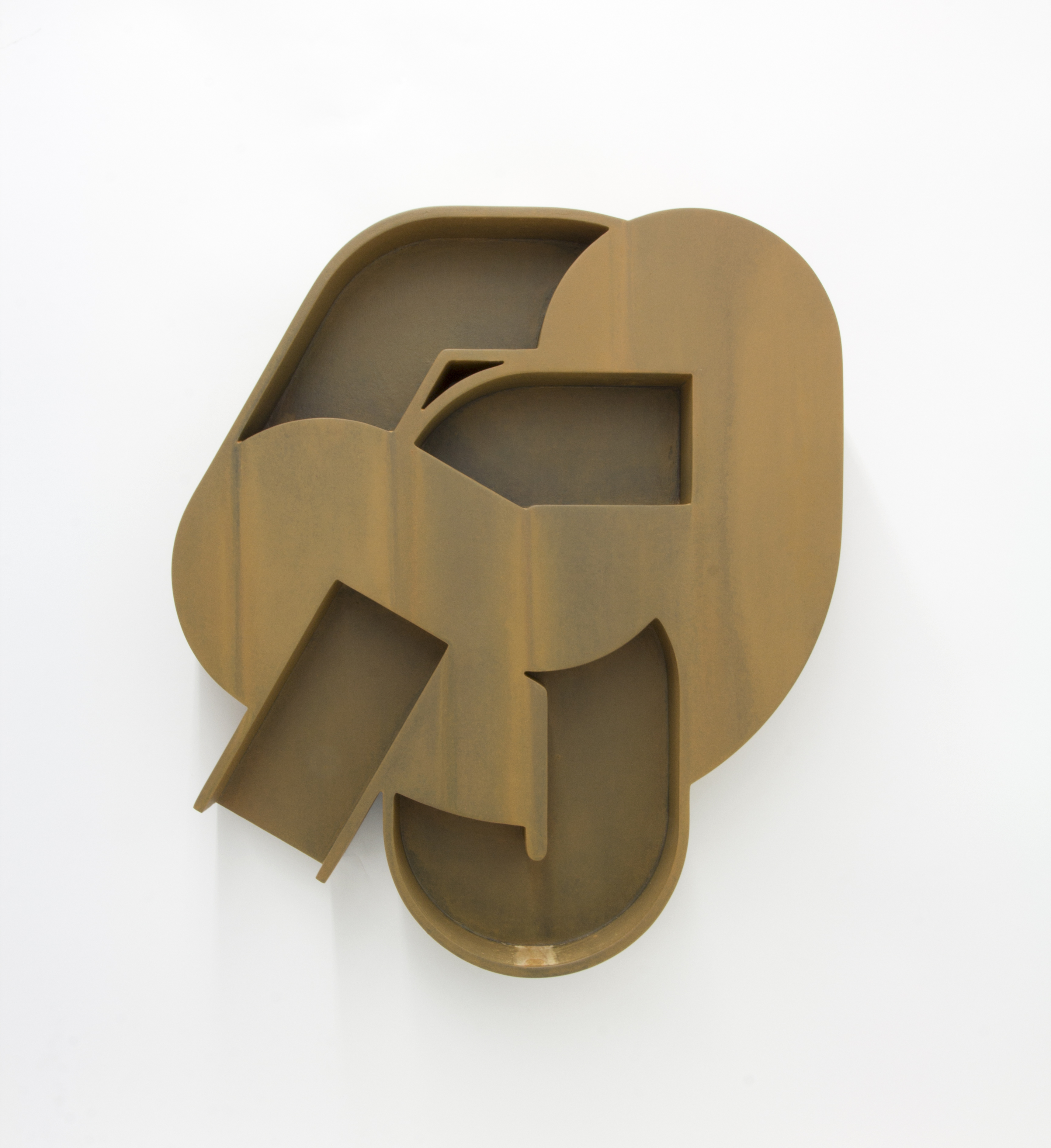


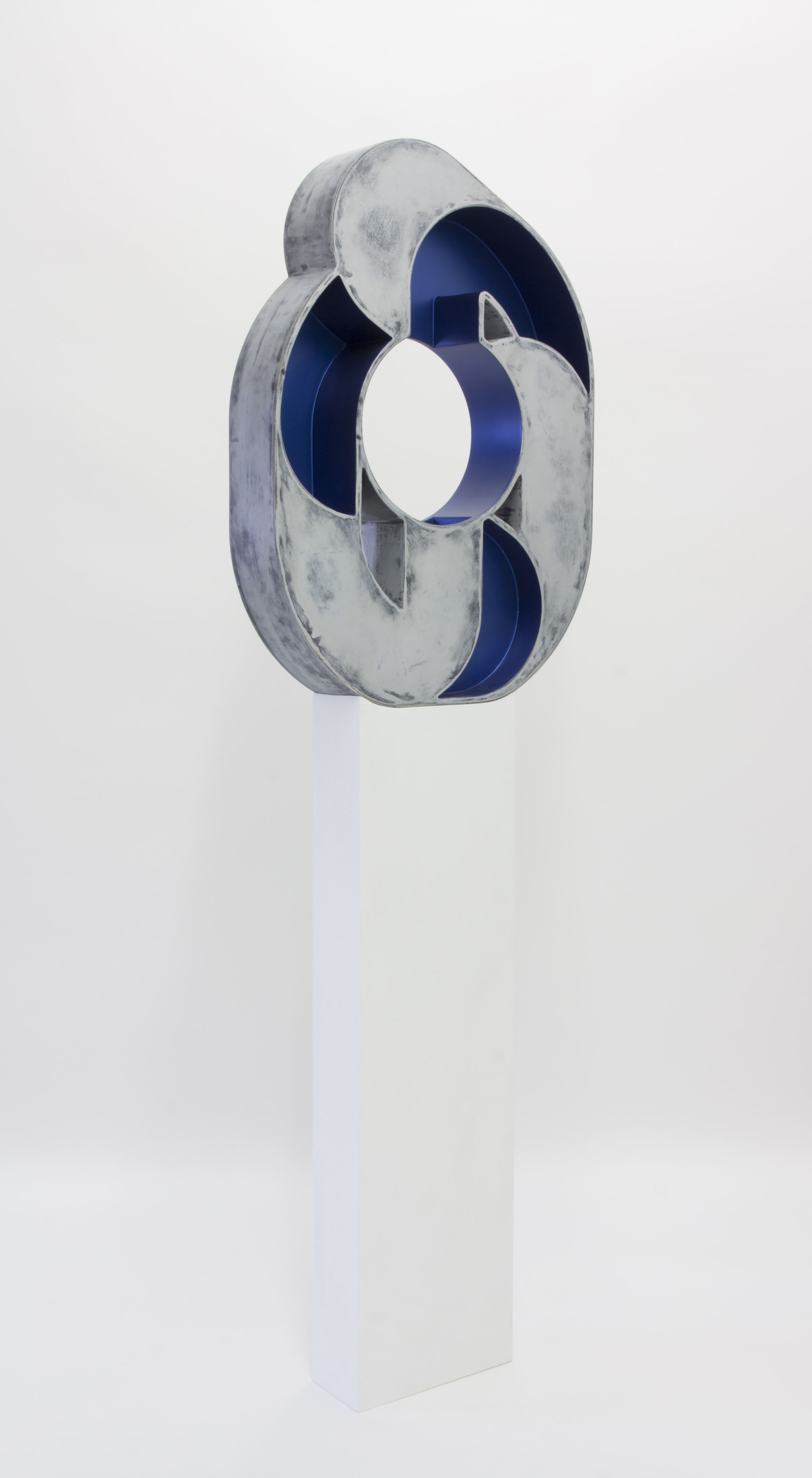
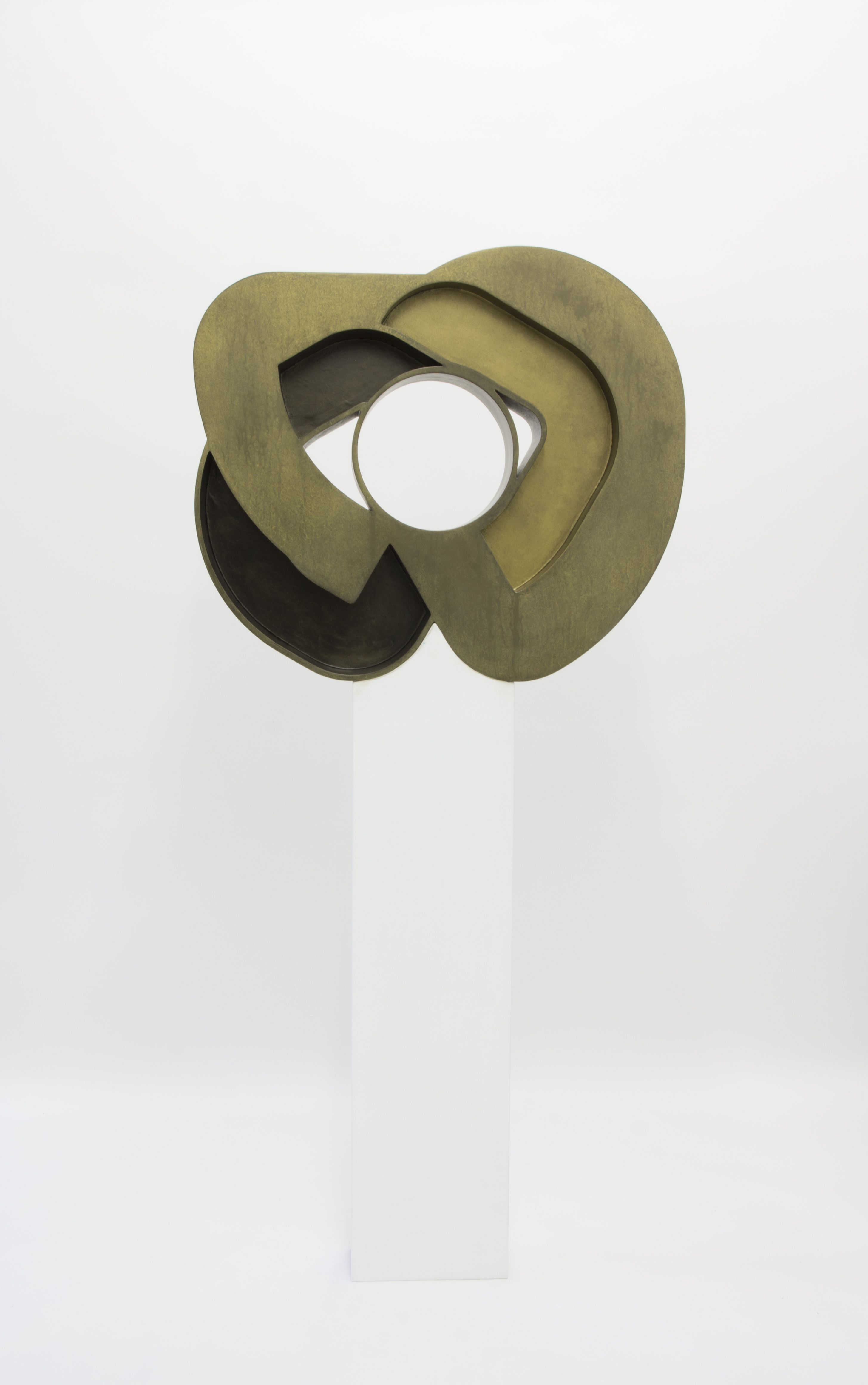
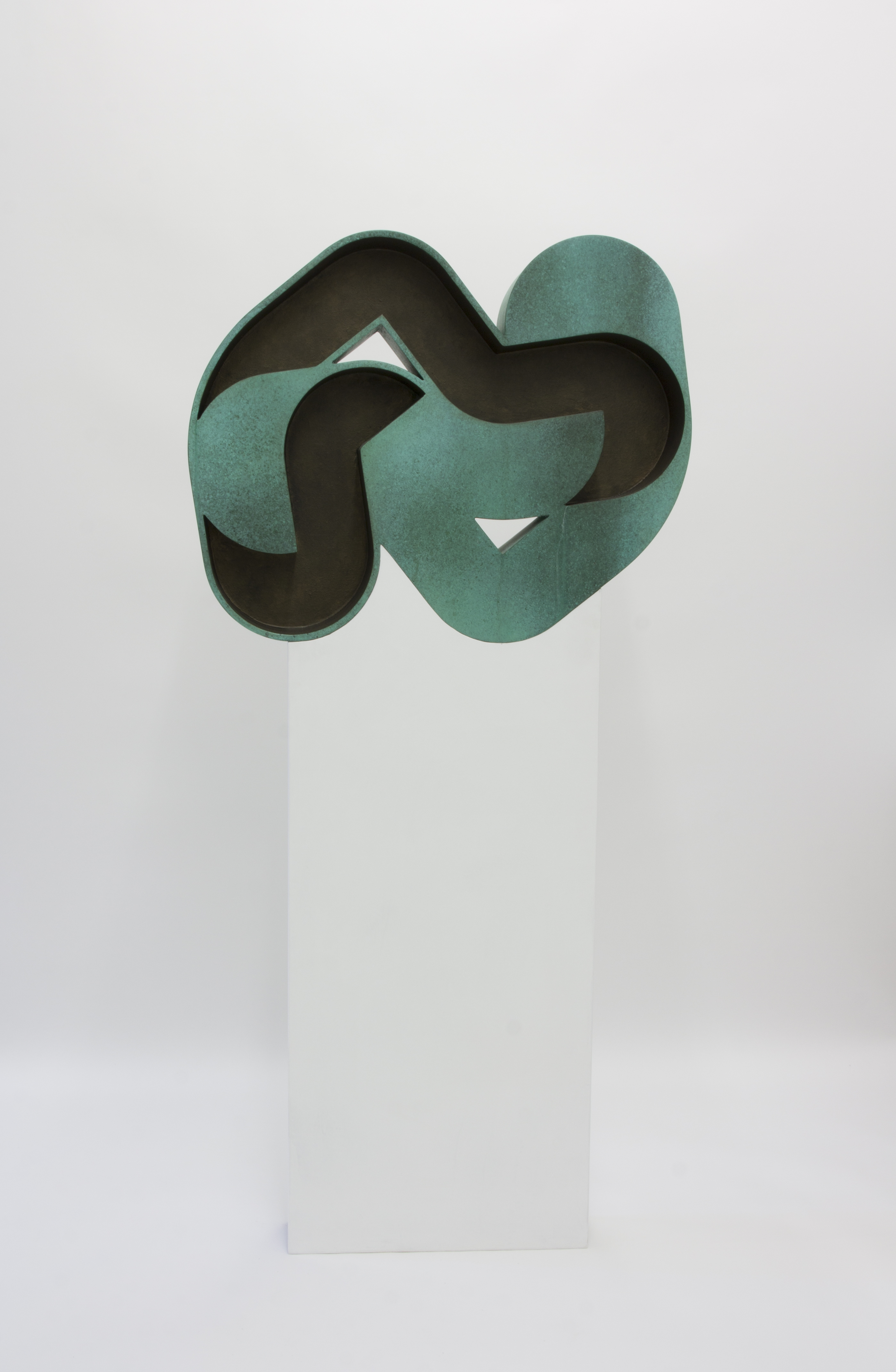
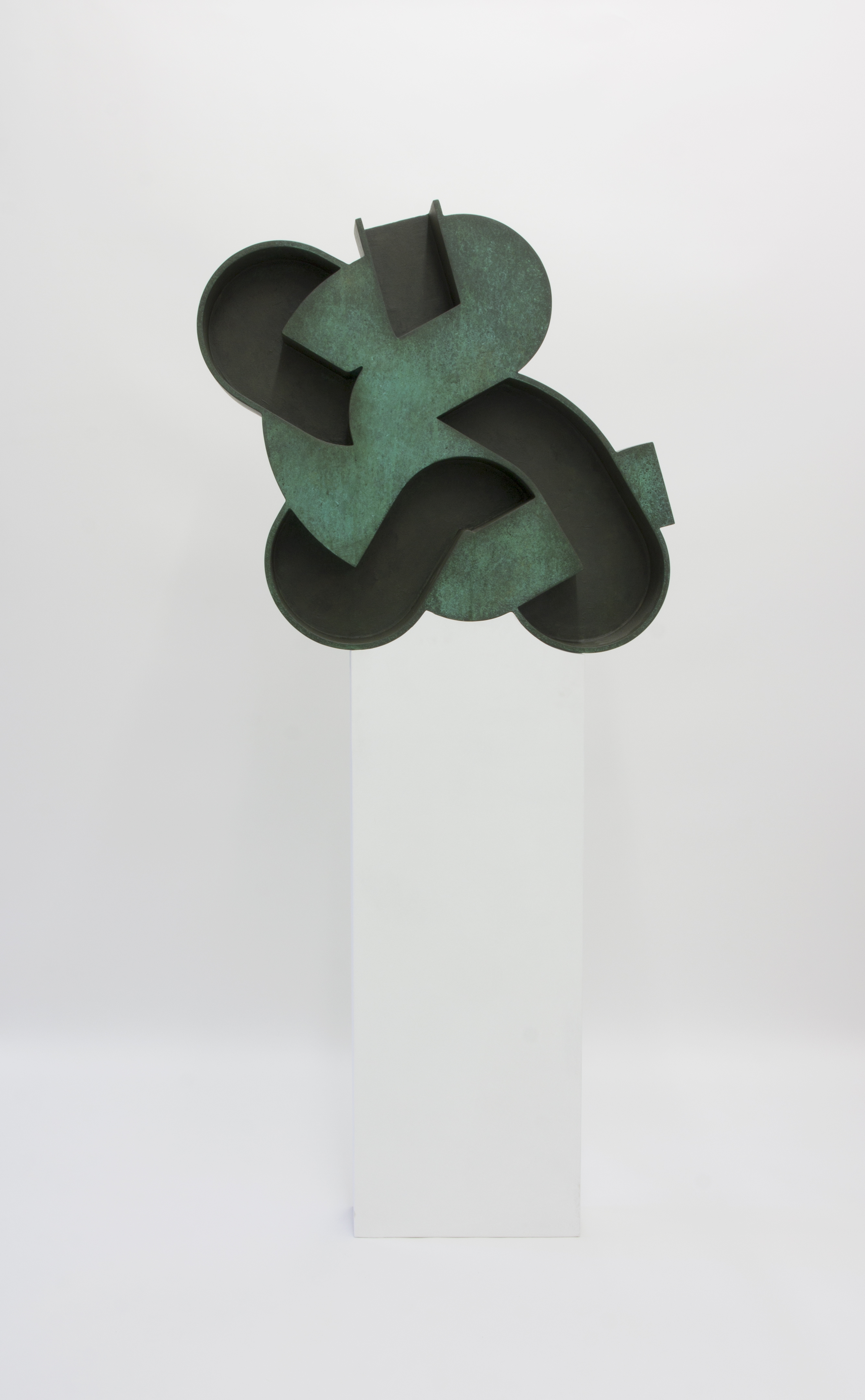
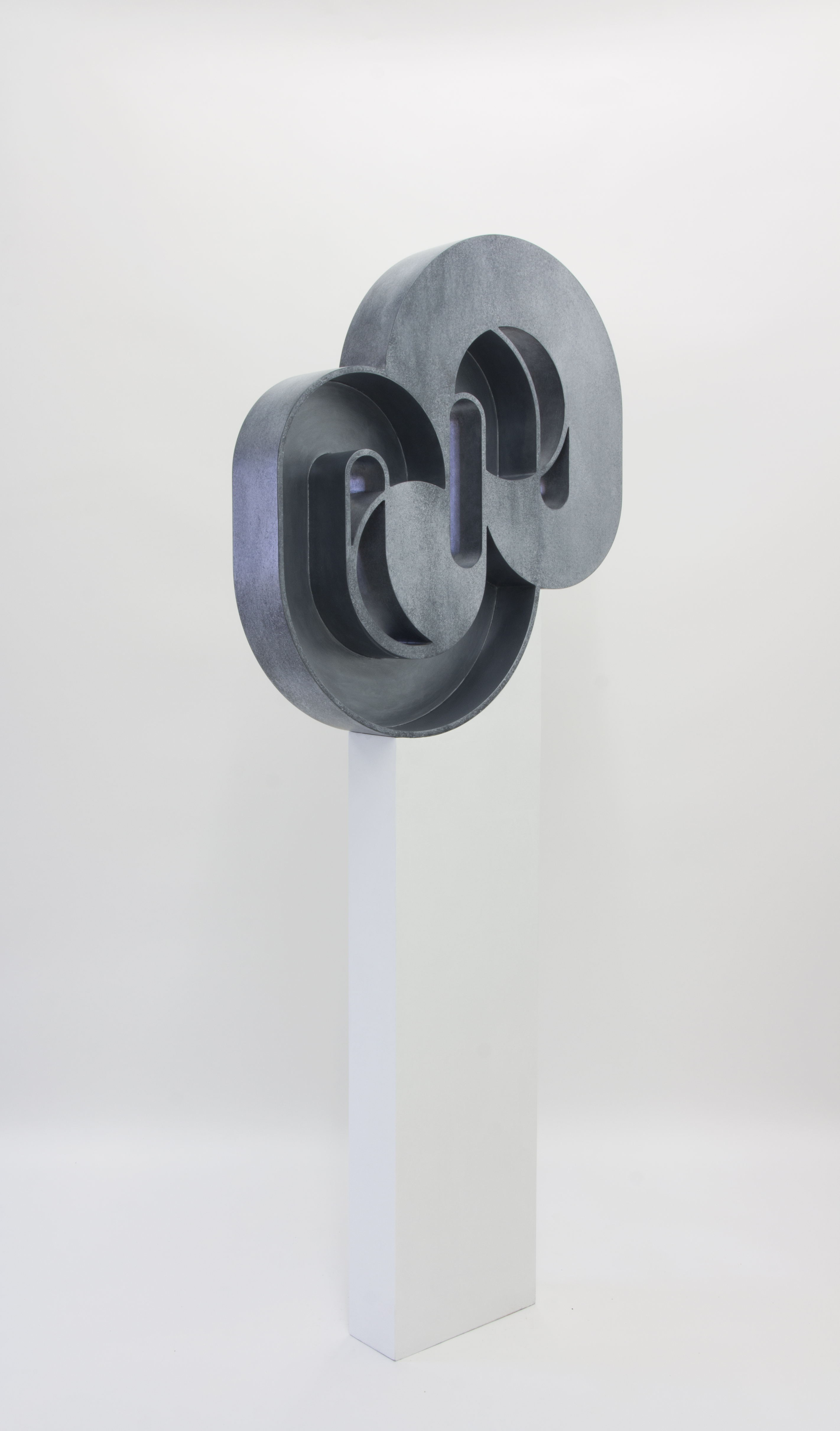
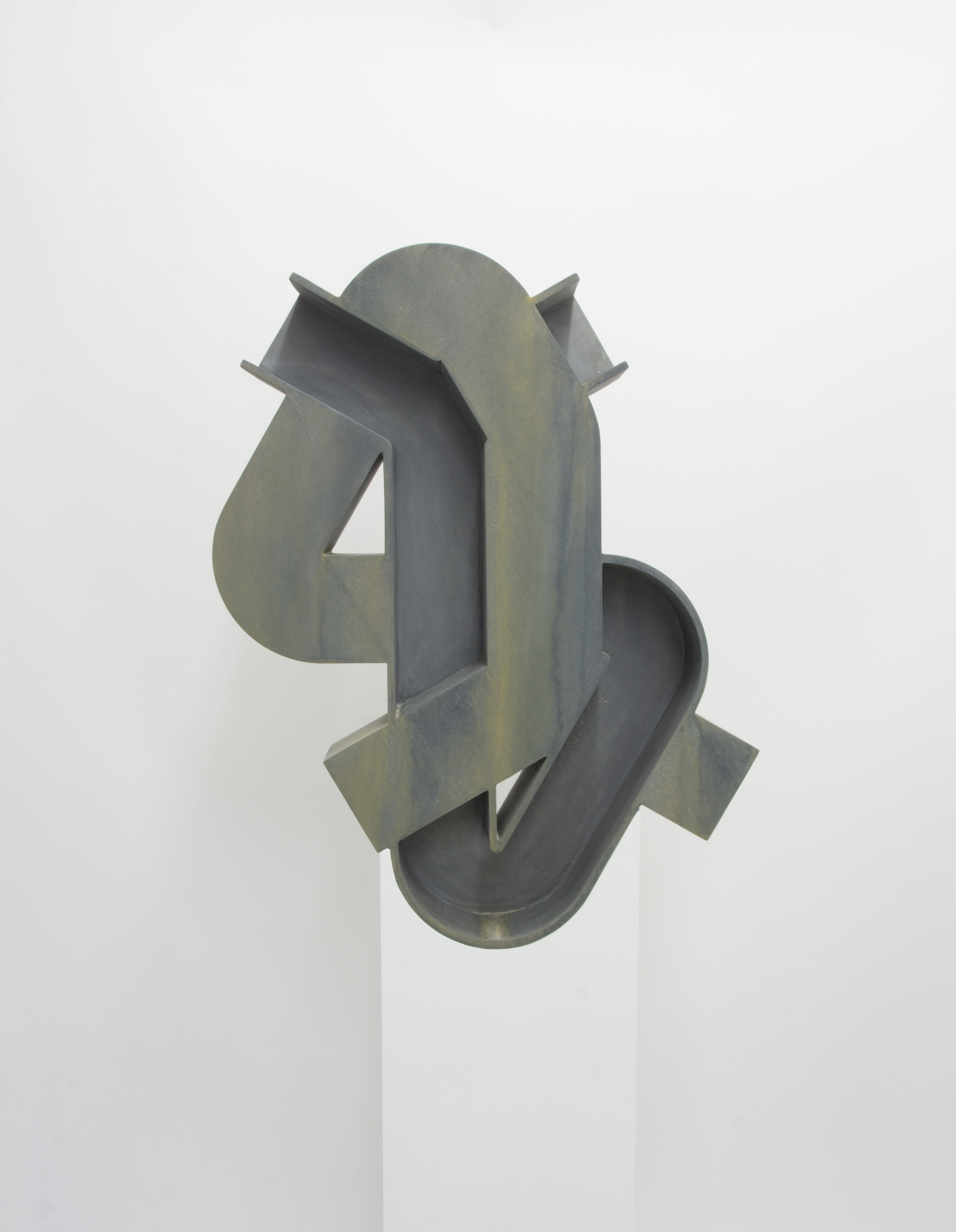

Things that Look Like Other Things
By Maura Brewer
A threshold is a strip of wood or metal at the bottom of a door that marks the passage between two rooms. It’s also the point at which something changes, or comes into effect, or one thing becomes its opposite. From a distance, Amir Nikravan’s objects resemble the large, metal sculptures of our public parks (like a Chamberlain or a Serra) but small, shrunk down to the language of interior design. The surfaces look like patinated bronze and brushed steel, but the illusion is tenuous. As your body moves closer to these objects, their organic, textured depth is revealed to be surface treatment – a faux finish made of speckled acrylic paint on thin wood veneer. If you look even closer, the hand of the artist is visible in the careful application of painted spots. This moment, when the “real” object is revealed to be an approximation, is a threshold. The sculptures are like toys or games, optical illusions that illicit a little pleasure and delight as something changes, magically, into its opposite. Depth is surface, heavy is light, real is fake.
Amir and I grew up in the 1990s, at the peak of faux finish interior design – sponge-painted walls that were supposed to suggest leather or some kind of fancy metallic surface. Suburban living rooms and foyers were decorated in stippled tones with stenciled borders around the edges. The faux finish is a sign of my middle class childhood, 90s DIY striving. Faux finish is always a little unserious, even when seen in the art gallery, removed from the visual language of middle class domesticity. Even the word is funny – “faux.” There’s nothing more American than appropriating the French language to lend an air of classiness to what’s really just fake, a classless understanding of class. Amir calls these sculptures “low tech approximations of objects that would cost tens of thousands of dollars to fabricate.” Faux finish is a cheap solution to a social problem. It’s trying to pass when you don’t have the resources, or the right look – you don’t belong.
Writing on Vaginal Davis’s drag performances of the 80s and 90s, José Esteban Muñoz says, “Passing is often not about bold-faced opposition to a dominant paradigm or a wholesale selling out to that form… The subject who passes can be simultaneously identifying with and rejecting a dominant form.” To try to pass is to protest against an exclusionary system while at the same time acting out a desire for that which has excluded you. Passing isn’t a pure politics of us against them. It acknowledges that the desire for power is not only out there, but inside me, in my wish to be recognized, to achieve success, to be loved. To pass is to remake yourself into the thing you want, to try to get a piece of a system that has rejected you.
Amir’s sculptures perform a version of passing, but through the formal and historical language of Sculpture. As an aesthetic gesture, passing, or mimicry, moves our understanding from actual to conceptual. When a “real thing” is met by its reproduction, its authenticity is undermined. The object becomes one in a line of potential duplicates, and we can grasp it as a concept – it becomes discursive. It’s not that Amir’s sculptures simply mimic the big metal sculptures of the 20th century, but, by reproducing them in faux finish, they invite us to think about the idea of “big metal Sculpture,” who has access to that kind of production, and who can only strive for that thing, while never quite achieving the thing itself. His sculptures point us to the economic reality that governs art production for the vast majority of artists: the demand to pass, to produce objects that look a certain way, achieve (or fake) a certain level of production value. To pass successfully in the art world usually means the invocation of white male histories, and the legitimacy and power they confer. We are expected to do this even when we can’t pay our bills and our credit cards are maxed.
Amir’s sculptures are superficial, by which I mean that the visual experience is one that redirects us back to the surface at every turn. Seen from the front, the objects appear dimensional, with dark interior compartments that recede into space. Viewed from the side, this dimensionality collapses. The sculptures are only a few inches deep, and more than that, the pedestals they sit on are only a few inches deep as well, and shaped to fit perfectly into the opposing curves at the bottom of the object, like puzzle pieces. They are more like facades than sculptures, as though made for a movie set and only meant to be seen from one angle. Or maybe more accurate: sculpture for Instagram, pre-flattened into photographic images. The flatness of the object mirrors the flatness of the faux finish surface. Everything that looks deep is shallow, a surface-level parody of Sculpture itself.
Amir’s parodic replication of authority is weird, unsettling. We’re accustomed to a certain kind of political art, in which the minoritarian subject claims their visibility in an act of celebration or defiance against the mainstream (loud and proud, etc.) But we are living in a moment in which global capitalism has seamlessly coopted the language of identity politics into the fabric of consumer culture. Artists are often asked to perform versions of themselves for social media, to package their subject position or life story as a marketing strategy. This performance of self, which looks, at first glance, like an affirmation of difference, conforms the subject to the demands of the market – and everyone’s difference starts to look weirdly similar, like so many check boxes on a grant application. When identity politics slides into glossy self-representation it becomes another kind of playing at legitimacy, with homogenizing effects.
Passing doesn’t perform identity politics in the usual way, it isn’t about personal expression, visibility or celebration. Passing is a politics of camouflage. It’s about trying to inhabit something from the inside by miming the language of authority. It’s for strivers, scammers, and 90s moms, carefully sponging paint onto their suburban walls. And when passing fails, that failure reveals something about the thing itself, and the exclusions that were there all along.
When I got out of graduate school, I (eventually) realized that I couldn’t afford to make my videos if I had to shoot everything myself, and that my practice would only survive if I stole the majority of my images from the many terrible Hollywood films that were already on the Internet. Once I started working with appropriated images, I realized that some of the legitimacy of the original film would magically transfer over to me. More than once, I’ve had a colleague or curator tell me that my work has “great production values” while looking at footage from a pirated cell phone video of Interstellar. This is also a kind of passing - passing off a lowbrow, jpeg-y version as a fancy thing, a thing you can’t actually have. There’s a perverse pleasure in seeing big Hollywood production values stripped down to cell phone resolution. Every time my work passes, I imagine that the original thing is worth a little less, is less exclusive, watered down by my very presence.
Amir’s objects draw us in, invoking the language of Sculpture, masculinity and power. But these are objects that play at the threshold between authenticity and falsehood, depth and surface. They pass, but not completely. As we look closer and the illusion comes undone, we can understand our desire for that illusion. The ability to maintain the veneer of power, to successfully pass, is a question of privilege and access, in other words, the systemic exclusions of the artworld that govern our lives. Art is a game of appearances, a posture of legitimacy mimed by the illegitimate. Art is a scam. Amir’s sculptures both reveal and enact that scam, luring us in, and then, at the threshold, letting the mask slip.